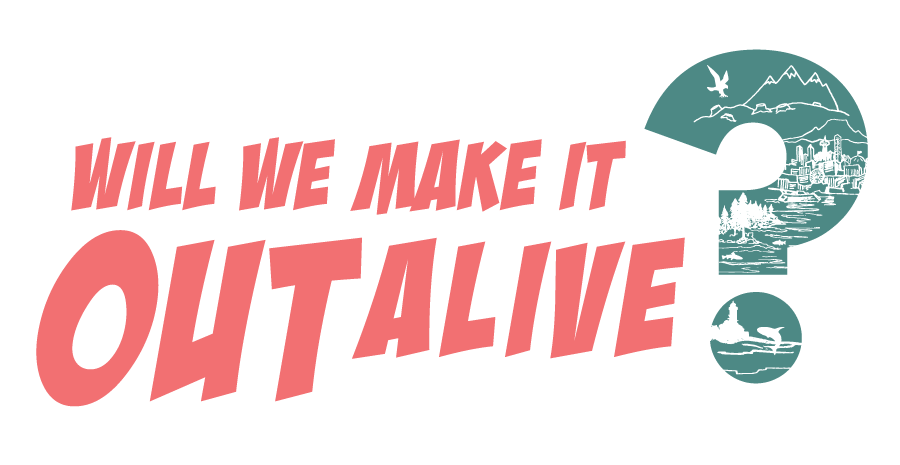Episode 7: Poop Happens
/Fecal Matters
In this episode we learn more about poop! We talk about poop troubles in Thailand and poop in shellfish. We also discuss how to navigate back to a site using your mapping grade GPS data. Finally, we offer information on the student GREEN congress and how you can help connect students to their watersheds!
First, we tell all about our own experience with food poisoning in a foreign country. What was the culprit?
Then we discuss the problem of poopy, toxic shellfish. No, we aren’t insulting them; shellfish eat whatever’s in their water, including toxins. While the toxins don’t hurt the shellfish, they do hurt anything- or anyone- that eats them. Even if you cook it! We discuss the effects this could have on people who eat nasty shellfish, including the different kinds of poopy illnesses they can share. For more information on shellfish-related illnesses straight from the Washington Department of Health, go here.
If they’re going down, they’re taking you with them!
So what can we do to prevent shellfish from being poopy? The Washington Department of Health has tips for handling, storing, and cooking shellfish safely. If you are harvesting shellfish, their tips for doing so safely can be found here. The Department of Health also has maps that provides shellfish safety information and biotoxin closures, which you can view here and here.
For general information about harvesting shellfish on the west coast, go here. If you’re planning on fishing or shellfishing in Washington, be sure to check out the Washington Department of Fish and Wildlife’s regulations and news. Many local jurisdictions also have their own shellfish harvesting webpages. Here’s the page for Clallam County.
Oregon has tons of resources regarding shellfish safety! The Oregon Department of Fish and Wildlife has information on commercial or recreational shellfish harvesting here. They also share information about biotoxins in shellfish. For regulation updates, check out the Oregon Recreational Harvest Report. The Oregon Department of Agriculture also has advisories, safety information, and closing information. For harvesting clams or mussels in Oregon, go here.
For those of you in British Columbia, here is information on recreational shellfish harvesting. For contamination and closing information in BC, go here.
How do you even tell shellfish apart? Here’s some identification info from the Washington Department of Health. You can even download this handy little PDF version!
Pictured: shellfish kryptonite
Other threats to shellfish and shellfish eaters include plastics and climate change. Check out this Oregon Public Broadcasting article to learn more about the effects of ocean trash on shellfish.
“An estimated 8 million tons of plastic end up in the ocean every year, putting the total number of ocean-going plastic pieces in the trillions. This debris includes consumer goods, like plastic water bottles, and industrial equipment, like abandoned fishing gear.”
The EPA has more information on how climate change effects shellfish that you can read about here.
While every country pollutes, according to the Ocean Conservancy, about two-thirds of plastic junk in the ocean comes from five countries: China, Indonesia, the Philippines, Vietnam and Sri Lanka. Some of it sinks, some of it gets to shores, but much of it gathers in a convergence zone of ocean currents called “The Great Pacific Garbage Patch”
And remember when we mentioned Alaska’s cat mayor? That’s real.
Wait, where’s that poop site again?!?
For our GIS Tool, we talk about using GPS units to navigate back to the locations you GPS-ed. For more information, check out the GIS blog!
For Citizen Science, we highlight the GREEN Congress in the South Puget Sound and Nisqually River Watershed school districts. This year, 500 students from 4th graders to high schoolers work with facilitators in small groups to monitor watershed sites, give a short presentation on the results, and come up with solutions to make things better in the watersheds. Evergreen State College hosts the GREEN Congress each March, sponsored by South Sound GREEN (Global Rivers Environmental Education Network) and the Nisqually River Education Project. For more information, go here or here.
As of early March, they are still looking for volunteers for the event on March 21! They are also always looking for volunteers to help the students with monitoring in October and February. For more information on getting involved, go here or here!
There are similar programs around Washington. In the Clark County, WA - Vancouver area, the City and County run a program with local schools and then team up with the Washington State University campus in Vancouver to host the culminating Student Watershed Congress in May of each year.
Serving you facts!
There are several other programs around Washington where students learn about and perform water quality sampling. The San Juan Islands has a project you can learn more about here. Shelton also has a similar program that you can learn more about here.
We also have a big announcement: we’re now moving to one episode a month to insure that our podcast is hilarious and high-quality (and so we can get around to all the other stuff we have to do). Episodes will premiere on the first Tuesday of every month, and Episode 8 will drop on April 2nd. Tune in for some fish flinging fun!
As always, please rate, review and subscribe on Apple Podcasts, Stitcher, or wherever you get your podcasts. Please let us know what you think at outalivepodcast.com or facebook.com/WillWeMakeItOutAlive. See you next month, but in the meantime, don’t be afraid to cut toxic shellfish out of your life!







